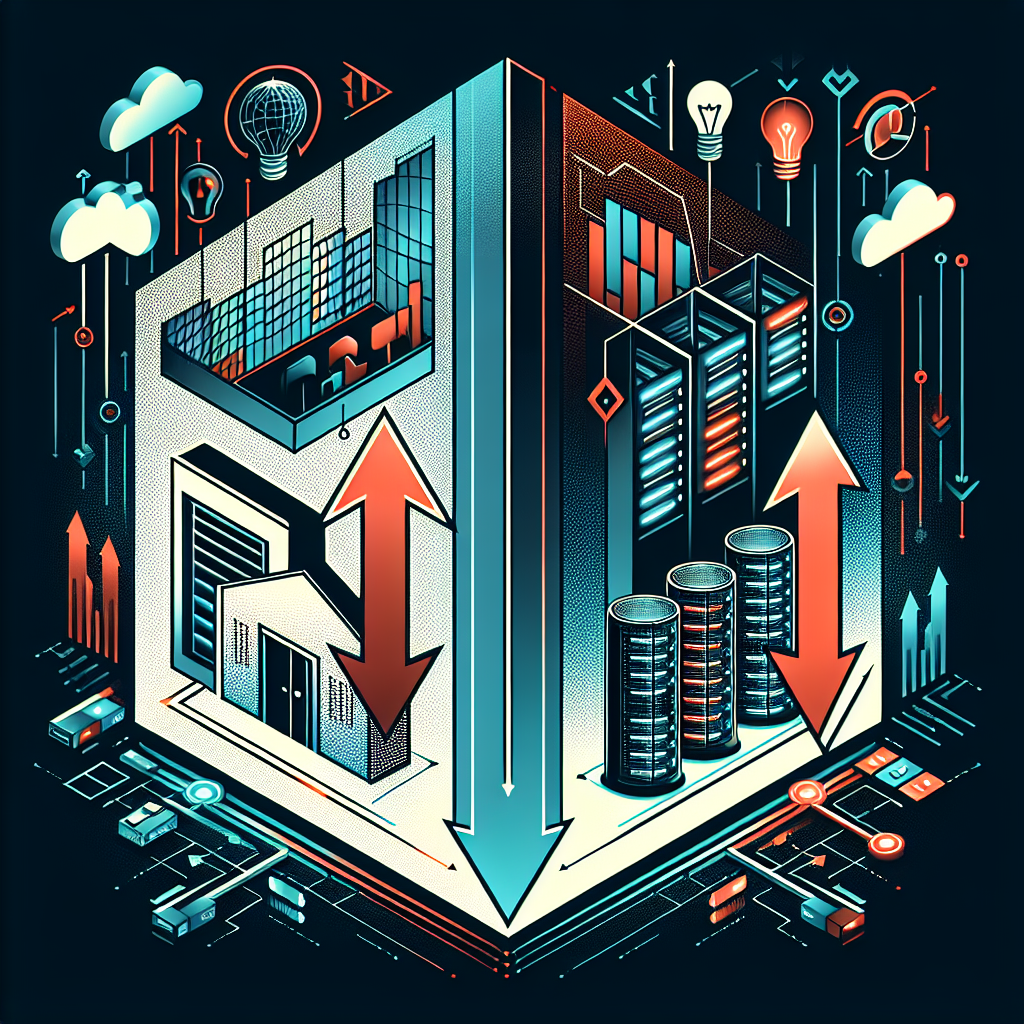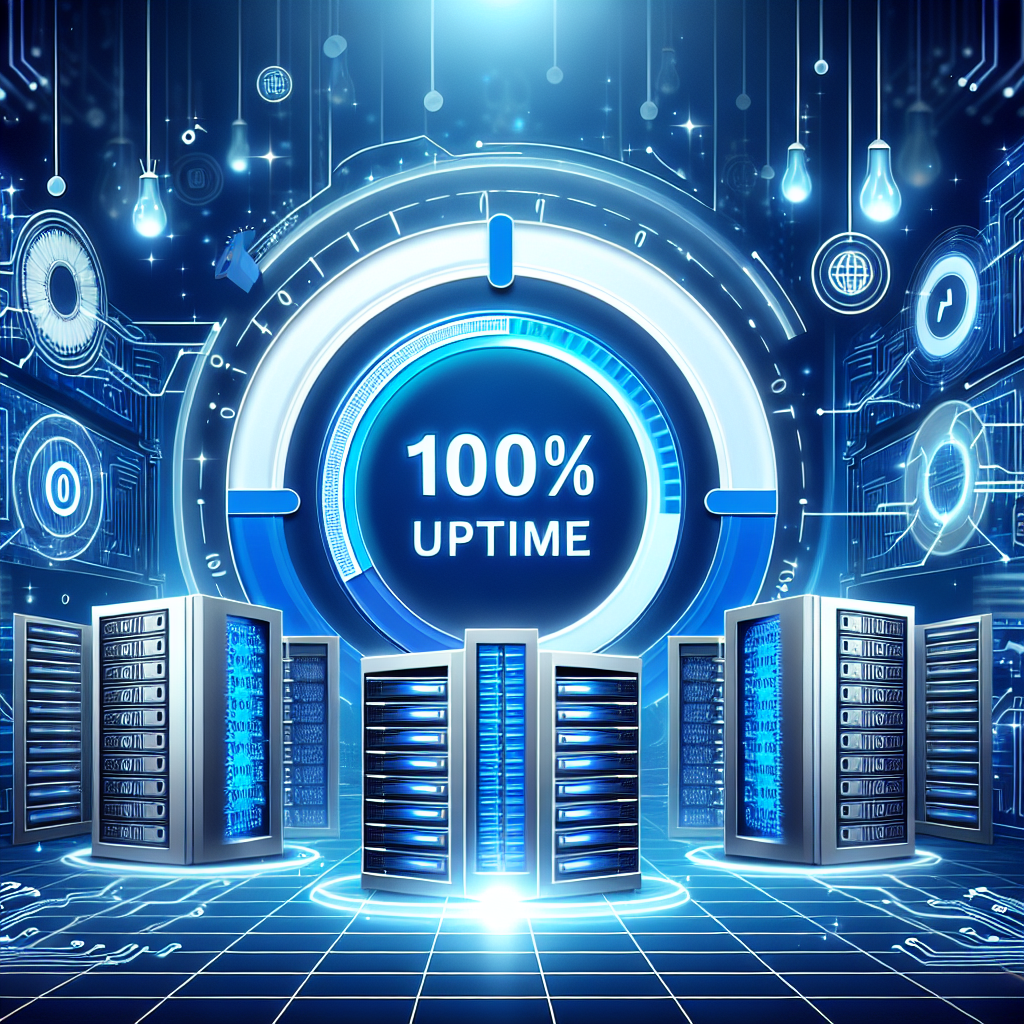Your cart is currently empty!
Tag: Data Center Uptime

How to Ensure High Uptime in Your Data Center
In today’s digital age, data centers are the backbone of many businesses, serving as the central hub for storing, processing, and managing vast amounts of information. With the increasing reliance on technology, ensuring high uptime in your data center is crucial to maintaining business operations and avoiding costly downtime.Here are some tips on how to ensure high uptime in your data center:
1. Implement a Redundant Power Supply: Power outages are one of the most common causes of downtime in data centers. To prevent this, it is important to have a redundant power supply in place. This can include backup generators, Uninterruptible Power Supply (UPS) systems, and dual power feeds to critical equipment.
2. Regular Maintenance and Testing: Regular maintenance and testing of equipment is essential to ensure that everything is in good working order. This includes checking for any signs of wear and tear, cleaning equipment, and conducting regular performance tests to identify any potential issues before they become critical.
3. Monitoring and Remote Management: Utilize monitoring tools and remote management software to keep an eye on your data center’s performance and quickly address any issues that arise. This can help you identify potential problems early on and take proactive measures to prevent downtime.
4. Temperature and Humidity Control: Data centers generate a significant amount of heat, which can lead to equipment failure if not properly controlled. Implementing effective temperature and humidity control systems can help prevent overheating and ensure that your equipment operates at optimal levels.
5. Security Measures: Security breaches can also lead to downtime in data centers, so it is important to implement robust security measures to protect your data and infrastructure. This can include physical security measures such as access control systems, as well as cybersecurity measures to prevent unauthorized access to your network.
6. Disaster Recovery Plan: Despite your best efforts, downtime can still occur due to unforeseen circumstances such as natural disasters or system failures. Having a comprehensive disaster recovery plan in place can help you quickly recover from any downtime and minimize its impact on your business operations.
By following these tips and implementing best practices in your data center, you can ensure high uptime and maintain the reliability of your infrastructure. Remember that downtime can have serious consequences for your business, so it is important to prioritize uptime and invest in the necessary resources to keep your data center running smoothly.

How Data Center Uptime Impacts Customer Satisfaction and Loyalty
In today’s digital age, data centers play a crucial role in ensuring that businesses can operate efficiently and effectively. These facilities house the servers, storage devices, and networking equipment that are essential for storing and processing data. As such, the uptime of a data center – or the amount of time that it is operational and available – is of utmost importance.Data center uptime directly impacts customer satisfaction and loyalty. When a data center experiences downtime, it can result in a loss of access to critical business applications, services, and data. This can disrupt operations, lead to lost revenue, and damage a company’s reputation. Customers expect and demand reliable access to the services and information they need, and any interruption in service can be frustrating and costly.
In a recent survey conducted by Ponemon Institute, it was found that the average cost of data center downtime is $9,000 per minute. This emphasizes the financial impact that downtime can have on a business. Additionally, downtime can also have a negative impact on customer satisfaction and loyalty. Customers who experience frequent outages or downtime are likely to become frustrated and may seek out alternative providers who can offer more reliable services.
On the other hand, data center uptime can positively impact customer satisfaction and loyalty. When a data center is able to consistently deliver high levels of uptime, customers can rely on the services and information they need to run their businesses effectively. This can lead to increased trust, loyalty, and satisfaction among customers. In fact, a study by the Uptime Institute found that companies with higher levels of uptime reported higher levels of customer satisfaction and loyalty.
To ensure high levels of uptime and maintain customer satisfaction and loyalty, businesses must invest in reliable data center infrastructure and implement robust monitoring and maintenance practices. Regularly monitoring the performance of data center equipment, conducting routine maintenance, and implementing redundancy measures can help minimize the risk of downtime and ensure that services remain available to customers.
In conclusion, data center uptime has a direct impact on customer satisfaction and loyalty. Businesses that prioritize uptime and invest in reliable infrastructure are more likely to retain customers, build trust, and drive loyalty. By ensuring that data centers are consistently operational and available, businesses can meet the expectations of customers and maintain a competitive edge in today’s digital landscape.

Best Practices for Monitoring and Maintaining Data Center Uptime
In today’s digital age, data centers play a crucial role in the operations of businesses and organizations. These facilities house and manage the critical IT infrastructure that supports various applications, services, and processes. Ensuring the uptime of a data center is essential to prevent costly downtime and maintain business continuity. To achieve this, IT professionals must follow best practices for monitoring and maintaining data center uptime.1. Implement a comprehensive monitoring system: Monitoring is the key to identifying potential issues before they escalate into major problems. Implementing a robust monitoring system that tracks various metrics such as temperature, humidity, power consumption, and network performance is essential. This system should provide real-time alerts and notifications to IT staff so they can address issues promptly.
2. Conduct regular inspections and maintenance: Regular inspections and maintenance are essential for preventing equipment failures and ensuring optimal performance. IT professionals should conduct routine checks of hardware components, such as servers, storage devices, and networking equipment, to identify any signs of wear or potential issues. Additionally, performing regular maintenance tasks, such as cleaning air filters and updating firmware, can help prevent downtime.
3. Implement redundancy and failover mechanisms: Redundancy is critical for ensuring data center uptime. IT professionals should implement redundant components, such as power supplies, cooling systems, and networking devices, to minimize the risk of single points of failure. Additionally, setting up failover mechanisms, such as backup power sources and redundant network connections, can help ensure uninterrupted operations in the event of an outage.
4. Conduct regular testing and disaster recovery drills: Testing is essential for validating the effectiveness of data center uptime strategies. IT professionals should conduct regular tests, such as load testing and failover testing, to identify any weaknesses in the system and address them proactively. Additionally, performing disaster recovery drills can help ensure that the data center can recover quickly in the event of a major outage or disaster.
5. Implement proper security measures: Security is a critical aspect of maintaining data center uptime. IT professionals should implement robust security measures, such as access controls, encryption, and intrusion detection systems, to protect the data center from unauthorized access and cyber threats. Regular security audits and updates are essential to ensure that the data center remains secure and operational.
By following these best practices for monitoring and maintaining data center uptime, IT professionals can ensure the reliability and availability of critical IT infrastructure. Preventing downtime is essential for maintaining business continuity and ensuring that operations run smoothly. Investing in a comprehensive monitoring system, conducting regular inspections and maintenance, implementing redundancy and failover mechanisms, conducting regular testing and disaster recovery drills, and implementing proper security measures are essential steps to achieve optimal data center uptime.

The Costs of Downtime: Why Investing in Data Center Uptime is Worth It
In today’s digital age, downtime is a costly and inconvenient reality for businesses that rely on data centers to keep their operations running smoothly. Whether it’s due to a power outage, equipment failure, or a cyber attack, downtime can have a significant impact on a company’s bottom line. That’s why investing in data center uptime is crucial for businesses looking to minimize the costs associated with downtime.The costs of downtime can be substantial, both in terms of lost revenue and damage to a company’s reputation. According to a recent study by the Ponemon Institute, the average cost of downtime for a business is around $9,000 per minute. This can add up quickly, with some businesses losing hundreds of thousands of dollars in just a single hour of downtime.
But the financial costs are just the tip of the iceberg when it comes to the impact of downtime. Downtime can also result in lost productivity, missed deadlines, and frustrated customers. In today’s fast-paced business environment, any disruption to operations can have a ripple effect throughout the entire organization.
Investing in data center uptime is one way that businesses can mitigate the risks associated with downtime. By ensuring that their data centers are equipped with the latest technology and security measures, businesses can minimize the likelihood of experiencing downtime in the first place. This can include implementing redundant power sources, backup generators, and advanced monitoring systems to quickly identify and resolve any issues that may arise.
While investing in data center uptime may require an upfront investment, the long-term benefits far outweigh the costs. By minimizing the risks of downtime, businesses can improve their operational efficiency, enhance their customer satisfaction, and protect their bottom line. In today’s competitive business landscape, investing in data center uptime is a smart decision that can pay off in the long run.

Understanding the Metrics of Data Center Uptime
Data center uptime is a crucial metric for any organization that relies on its IT infrastructure to operate efficiently. Understanding the metrics of data center uptime is essential for ensuring that your business is able to maintain a high level of availability for its critical systems and applications.Data center uptime is typically measured as a percentage of time that a data center is operational and available to users. The most common metric used to measure uptime is the Tier system, which was developed by the Uptime Institute. The Tier system categorizes data centers into four levels, with Tier 1 being the lowest level of uptime and Tier 4 being the highest.
Tier 1 data centers have an uptime of 99.671%, which equates to around 28.8 hours of downtime per year. Tier 2 data centers have an uptime of 99.741%, which equates to around 22 hours of downtime per year. Tier 3 data centers have an uptime of 99.982%, which equates to around 1.6 hours of downtime per year. Tier 4 data centers have an uptime of 99.995%, which equates to around 26 minutes of downtime per year.
It is important for organizations to understand the metrics of data center uptime in order to ensure that they are able to meet their operational requirements. By understanding the different levels of uptime and the associated downtime, organizations can make informed decisions about the type of data center that is best suited to their needs.
In addition to the Tier system, there are other metrics that can be used to measure data center uptime. These include Mean Time Between Failures (MTBF), Mean Time to Repair (MTTR), and Availability. MTBF measures the average time between failures in a system, while MTTR measures the average time it takes to repair a system after a failure. Availability is a measure of how often a system is operational and available to users.
By understanding these metrics, organizations can better assess the reliability and availability of their data center infrastructure. This knowledge can help organizations to identify areas for improvement and implement strategies to enhance the uptime of their data center.
In conclusion, understanding the metrics of data center uptime is essential for ensuring that organizations are able to maintain a high level of availability for their critical systems and applications. By measuring uptime using metrics such as the Tier system, MTBF, MTTR, and Availability, organizations can make informed decisions about their data center infrastructure and implement strategies to enhance uptime.

Tips for Ensuring High Data Center Uptime
Data centers are the backbone of modern businesses, housing critical IT infrastructure and storing valuable data. Ensuring high uptime for data centers is crucial to minimize downtime and ensure continuous operations. Here are some tips for ensuring high data center uptime:1. Implement Redundant Systems: Redundancy is key to ensuring high uptime in data centers. This includes having redundant power supplies, cooling systems, networking equipment, and server hardware. Redundant systems can help prevent single points of failure and ensure that the data center can continue to operate even if one component fails.
2. Regular Maintenance and Inspections: Regular maintenance and inspections are essential to identify and address potential issues before they cause downtime. This includes checking power systems, cooling systems, and networking equipment regularly to ensure they are functioning properly. Regular inspections can help prevent unexpected failures and minimize downtime.
3. Monitoring and Alerting: Implementing a comprehensive monitoring and alerting system can help data center operators quickly identify and address issues that could lead to downtime. Monitoring systems can track key metrics such as temperature, humidity, power usage, and network traffic, and alert operators when these metrics exceed predefined thresholds.
4. Disaster Recovery Planning: Having a robust disaster recovery plan in place is essential to ensure high uptime in the event of a catastrophic failure. This includes regularly backing up data, testing backups to ensure they can be restored quickly, and having a plan in place to quickly recover operations in the event of a disaster.
5. Regular Testing: Regularly testing backup systems, disaster recovery plans, and failover mechanisms is essential to ensure they are functioning properly and can be relied upon in the event of a failure. Testing can help identify any weaknesses in the data center’s infrastructure and allow operators to address them before they cause downtime.
6. Staff Training: Ensuring that data center staff are properly trained in how to operate and maintain critical systems is essential to ensuring high uptime. Proper training can help prevent operator errors that could lead to downtime and ensure that staff are prepared to quickly address issues when they arise.
By implementing these tips, data center operators can help ensure high uptime and minimize downtime, ensuring that critical IT infrastructure and data remain available and accessible to support business operations.

How Downtime Can Impact Your Business and Why Data Center Uptime is Crucial
In today’s fast-paced business world, downtime can have a significant impact on your bottom line. Whether it’s due to a power outage, equipment failure, or a cyber attack, any interruption to your business operations can lead to lost revenue, damaged customer relationships, and a tarnished reputation. That’s why ensuring data center uptime is crucial for the success of your business.Data centers are the backbone of modern businesses, housing the servers, storage, and networking equipment that enable organizations to store, process, and access their critical data and applications. Without a reliable data center infrastructure, businesses are at risk of experiencing costly downtime that can disrupt operations and negatively impact their bottom line.
One of the main reasons why data center uptime is crucial is because downtime can result in significant financial losses. According to studies, the average cost of data center downtime is around $9,000 per minute. This can add up quickly, especially for large enterprises that rely heavily on their data center infrastructure to support their daily operations. In addition to the direct financial losses, downtime can also lead to lost productivity, missed opportunities, and decreased customer satisfaction.
Furthermore, downtime can also damage your business’s reputation and credibility. In today’s digital age, customers expect businesses to be available 24/7, and any interruption to your services can lead to frustration and dissatisfaction. This can result in customers taking their business elsewhere, leading to a loss of revenue and potential long-term damage to your brand.
To mitigate the risks associated with downtime, businesses need to invest in reliable data center infrastructure and implement robust disaster recovery and business continuity plans. This includes ensuring that your data center is equipped with redundant power supplies, cooling systems, and network connections to minimize the risk of downtime. Regular maintenance and monitoring of your data center infrastructure are also essential to identify and address any potential issues before they escalate into major problems.
In conclusion, downtime can have a significant impact on your business, leading to financial losses, damaged reputation, and lost opportunities. That’s why ensuring data center uptime is crucial for the success of your business. By investing in reliable data center infrastructure and implementing robust disaster recovery and business continuity plans, you can minimize the risks associated with downtime and ensure that your business remains operational and competitive in today’s fast-paced digital economy.

Strategies for Maximizing Data Center Uptime
Data centers are the heart of any organization’s IT infrastructure, housing critical systems and information that are vital for the day-to-day operations of businesses. Ensuring maximum uptime for data centers is crucial to avoid costly downtime and potential losses in revenue and productivity. Here are some strategies that organizations can implement to maximize data center uptime:1. Redundancy and Resilience: One of the key strategies for maximizing data center uptime is to build redundancy and resilience into the infrastructure. This includes having backup power supplies, cooling systems, networking equipment, and servers in place to ensure that there are no single points of failure that can bring down the data center. Redundant components and systems can help to mitigate the impact of any hardware failures or outages.
2. Regular Maintenance and Monitoring: It is essential to conduct regular maintenance and monitoring of data center equipment to identify any potential issues before they escalate into full-blown problems. Monitoring tools can help to track the performance and health of data center systems in real-time, allowing IT staff to proactively address any issues and prevent downtime.
3. Capacity Planning: Proper capacity planning is crucial for ensuring that data center resources are able to meet the demands of the organization’s IT infrastructure. By accurately forecasting future growth and demand, organizations can scale their data center resources accordingly to prevent overloading systems and causing downtime.
4. Disaster Recovery and Business Continuity: Having a robust disaster recovery and business continuity plan in place is essential for minimizing downtime in the event of a catastrophic event or system failure. Organizations should regularly test and update their disaster recovery plans to ensure that they are able to quickly recover data and systems in the event of an outage.
5. Staff Training and Education: Investing in staff training and education is important for ensuring that data center personnel are equipped with the knowledge and skills to effectively manage and maintain data center systems. Properly trained staff can help to identify and resolve issues quickly, minimizing downtime and ensuring maximum uptime.
In conclusion, maximizing data center uptime requires a combination of proactive planning, redundancy, regular maintenance, and staff training. By implementing these strategies, organizations can minimize the risk of downtime and ensure that their data center remains operational and reliable.

The Importance of Achieving 100% Data Center Uptime
Data centers are the backbone of modern businesses, housing the critical IT infrastructure that supports daily operations. Ensuring that data centers are running smoothly and efficiently is crucial to maintaining business continuity and preventing costly downtime. One key metric that data center operators strive to achieve is 100% uptime, meaning that the data center is operational and accessible 24/7 without any interruptions.The importance of achieving 100% data center uptime cannot be overstated. Downtime can have serious consequences for businesses, including financial losses, damage to reputation, and loss of customer trust. In today’s digital age, where businesses rely heavily on data and technology to operate, even a few minutes of downtime can have a significant impact on productivity and revenue.
One of the main reasons why achieving 100% data center uptime is so critical is the growing reliance on digital services. With more and more businesses moving their operations online, any disruption to data center services can have cascading effects on other areas of the business. For example, e-commerce websites may experience a loss of sales if customers are unable to access the site, and online services may be inaccessible to users, leading to frustration and dissatisfaction.
In addition to financial losses, downtime can also damage a company’s reputation. Customers expect businesses to be available and responsive at all times, and any disruption to services can result in negative reviews and a loss of trust. This can be particularly damaging in industries where downtime can have serious consequences, such as healthcare or finance.
Achieving 100% data center uptime requires a proactive approach to monitoring and maintenance. Data center operators must invest in robust infrastructure, redundant systems, and backup solutions to ensure that services remain operational even in the event of hardware failures or natural disasters. Regular testing and maintenance are also essential to identify and address any potential issues before they escalate into full-blown outages.
In conclusion, achieving 100% data center uptime is essential for businesses to maintain their competitive edge and ensure the smooth operation of critical IT infrastructure. By investing in the right technology and adopting a proactive approach to monitoring and maintenance, data center operators can minimize the risk of downtime and ensure that their services remain reliable and accessible to customers at all times.

The Financial Impact of Data Center Downtime: Calculating the Cost
Data centers play a crucial role in modern businesses, serving as the backbone of IT infrastructure and housing critical data and applications. However, data center downtime is a serious concern for organizations, as it can have a significant financial impact. In fact, according to a recent study by the Ponemon Institute, the average cost of data center downtime is $740,357 per incident.There are several factors that contribute to the financial impact of data center downtime. First and foremost, there is the cost of lost revenue. When a data center goes down, businesses are unable to access critical applications and data, leading to a loss of productivity and potential sales. In addition, customers may be unable to access services or make purchases, resulting in lost revenue and potential damage to the organization’s reputation.
Furthermore, there are costs associated with restoring the data center to full functionality. This may involve replacing hardware, software, or other equipment that was damaged during the downtime. Additionally, organizations may need to invest in additional resources, such as IT staff or consultants, to address the root cause of the downtime and prevent future incidents.
There are also indirect costs to consider when calculating the financial impact of data center downtime. For example, there may be legal fees or fines associated with data breaches or compliance violations resulting from a downtime incident. Additionally, businesses may incur costs related to customer refunds, compensation, or credit monitoring services in the event of a data breach.
To calculate the cost of data center downtime, organizations should consider both the direct and indirect costs associated with the incident. This may include lost revenue, restoration costs, legal fees, and other expenses. By understanding the financial impact of data center downtime, businesses can better prepare for and mitigate the risks associated with these incidents.
In conclusion, data center downtime can have a significant financial impact on organizations. By calculating the cost of downtime and taking steps to prevent and mitigate these incidents, businesses can minimize the risks and ensure the continued operation of their critical IT infrastructure.
